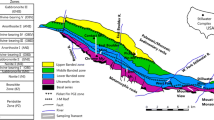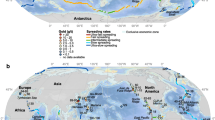Abstract
Massive sulfides recovered from the Kebrit Deep carbonaceous sedimentary succession represent black smoker fragments, novel to any Red Sea brine pool deposit. Chimneys, which were also observed in situ near the seawater/brine interface of the Kebrit Deep pool, are primarily comprised of Fe-, Zn- and Pb-bearing phases, and are often tar and asphalt impregnated. Cu-sulfides are virtually absent from parageneses, contrasting rift-related smoker and Red Sea metalliferous sediment deposits. Concentration of nickel in discrete bravoite points to a basalt/seawater leaching process as a source for most metals. The sedimentary package, which probably hosts Cu-mineralization in lower stockworks of the smoker deposit, is considered the major source of lead. Prevention of boiling of hydrothermal fluids, passing through a succession of organic-rich carbonate and clay horizons prior to discharge, is essential for smoker formation. Shaban Deep sedimentary-hosted massive sulfides are less frequent, with pyrite being the dominant ore mineral. Sulfur isotope data indicate both high temperature inorganic as well as biogenic sulfate (seawater and/or evaporite) reduction in sulfide-forming processes. Cogenetic sulfates formed from residual, bacteriogenically reduced seawater sulfate. Rather low sulfide/sulfate precipitation temperatures of 110–130 °C for the Kebrit brine pool and 100 °C for Shaban Deep massive sulfides are evident.
Similar content being viewed by others
References
Bäcker, H. (1982) Metalliferous sediments of hydrothermal origin from the Red Sea. — In: Degens, E.T. (ed.) Marine mineral deposits (Marine Rohstoffe und Meerestechnik), Vol. 6: Glückauf Essen, pp 102–136
Berner, R.A. (1971) Principles of elemental sedimentology. McGraw-Hill, New York, p. 205
Bignell, R. (1975) Timing, distribution and origin of submarine mineralization in the Red Sea. — Inst. Min. Met. Trans. B84, B1-B6
Bischoff, J.L., Rosenbauer, R.J., Aruscavage, P.J., Baedecker, P.A., Crock, J.G. (1983) Seafloor massive sulfide deposits from 21°N, EPR Juan de Fuca Ridge and Galapagos Rift. Bulk chemical composition and economic implications. — Econ. Geol. 78:1711–1720
Bischoff, J.L., Pitzer, K.S. (1985) Phase relations and adiabats in soiling seafloor geothermal systems. — Earth Planet. Sci. Lett. 75:327–338
Bonatti, E. (1985) Punctiform initiation of seafloor spreading in the Red Sea during transition from a continent to an oceanic rift. — Nature 316:33–37
CASM (Canadian-American Seamount Expedition) (1985) Hydrothermal vents on an axis seamount of the Juan de Fuca Ridge. Nature 313:212–214
Degens, E.T., Ross, D.A., eds. (1969) Hot brines and recent heavy metal deposits in the Red Sea. Springer, Berlin Heidelberg New York
Delaney, J.R., Cosens, B.A.: Boiling and metal deposition in submarine hydrothermal systems. Marine Tech. Soc. Jour. 16: 62–66
Delevaux, M.H. (1967) Preliminary lead isotope investigations of brine from the Red Sea, galena from the Kingdom of Saudi Arabia, and galena from United Arab Republic (Egypt). — Earth Planet. Sci. Lett. 3:139–144
Girdler, R.W., Southern, T.C. (1987) Structure and evolution of the northern Red Sea. — Nature 330:716–721
Girdler, R.W., Whitmarsh, R.B. (1974) Miocene evaporites in Red Sea cores, their relevance to the problem of the width and age of oceanic crust beneath the Red Sea. — In: Whitmarsh, R.B., Weser, P.E., Ross, D.A. (eds.) Initial reports of the Deep Sea drilling project, vol. 23. 913—921; U.S. Government Printing Office, Washington, pp. 913–921
Hekinian, R., Fouquet, Y. (1985). Volcanism and metallogenesis of axial and off-axial structures on the East Pacific Rise near 13°N. — Econ. Geol. 80:221–249
Kajiwara, Y., Krouse, H.R. (1971) Sulfur isotope partitioning in metallic sulfide systems. Can. J. Earth Sci. 8:1397–1408
Kawka, O.E., Simoneit, B.R.T. (1987) Survey of hydrothermallygenerated petroleums from the Guaymas Basin spreading center. — Org. Geochem. 11:311–328
Kerrich, R., Hodder, R.W. (1982) Archean lode gold and base metal deposits: Evidence for metal separation into independent hydrothermal systems. — Can. Inst. Min. Met. 24:144–160
Kissin, S.A. (1974) Phase relations in a portion of the Fe-S system. Ph.D. thesis, University of Toronto, Canada
Ku, T.L., Thurber, D.L., Mathieu, G.G. (1969) Radiocarbon chronology of Red Sea sediments. — In: Degens, E.T., Ross, D.A. (eds.) Hot brines and recent heavy metal deposits of the Red Sea. Springer, Berlin Heidelberg New York, pp 474–498
Kullerud, G. (1967) Sulfide studies. In: Abelson, P.H. (ed.) Researches in Geochemistry. John Wiley and Sons, New York, pp 286–321
Michaelis, W., Jenisch, A., Richnow, H.H. (1990) Hydrothermal petroleum generation in Red Sea sediments from the Kebrit and Shaban Deeps. — Appl. Geochem. 5:103–114
Mustafa, H.E.Z., Nawab, Z., Horn, R., Lelann, F. (1984) Economic interest of hydrothermal deposits. The Atlantis II project. — Proc. Offshore Mineral Resources, 2nd Intl. Seminar, Brest, France, pp. 509–539
Oudin, E., Thisse, Y., Ramboz, C. (1984) Fluid inclusions and mineralogical evidence for high-temperature saline hydrothermal circulation in the Red Sea metalliferous sediments: Preliminary results. Marine Mining 5:3–31
Pautot, G. (1983) Les fosses de la Mer Rouge: Approche geomorphologique d'un stade initial d'ouverture oceanique reealisee a l'aide du Seabeam. — Ocean. Acta 6:235–244
Pautot, G., Guennoc, P., Coutelle, A., Lyberis, N. (1984) Discovery of a large brine deep in the northern Red Sea. — Nature 310:133–136
Puchelt, H., Laschek, D. (1984) Marine Erzvorkommen im Roten Meer. — Fridericiana, Zeitschrift der Universität Karlsruhe, Heft 34, 3–17
Rasmy, M. (1981) Trace-element content of galena and associated minerals in some Miocene lead-zinc deposits near Red Sea coast, Egypt. Geol. Rund. 70:874–881
Sakai, H. (1968) Isotopic properties of sulfur compounds in hydrothermal processes. — Geochim. Cosmochim. Acta 12:150–169
Scott, S.D. (1983) Basalt and sedimentary hosted seafloor polymetallic sulphide deposits and their ancient analogues. — MTSIEEE Conference “Oceans '83”, San Francisco
Scott, S.D. (1985) Seafloor polymetallic sulfide deposits: Modern and ancient. — Mar. mining 5:191–212
Scott, S.D. (1987) Seafloor polymetallic sulfides: Scientific curiosities or mines of the future? — In: Teleki, P. (ed.) Proceedings NATO Advanced Research Workshop on “Marine Minerals: Resource Assessment Strategies”. D. Reidel Publishing Co., Dordrecht, pp. 227–300
Shanks, W.C., Bischoff, J.L. (1977) Ore transport and deposition in the Red Sea geothermal system: A geochemical model. Geochim. Cosmochim. Acta 41:1507–1519
Simoneit, B.R.T., Lonsdale, P.F. (1982) Hydrothermal petroleum in mineralized mounds at the seabed of Guaymas Basin. Nature 295:198–202
Styrt, M.M., Brackmann, A.J., Holland, H.D., Clark, B.C., Pisutha-Arnond, V., Eldridge, C.S., Ohmoto, H. (1981) The mineralogy and the isotopic composition of sulfur in hydrothermal sulfide/sulfate deposits on the East Pacific Rise, 21°N latitude. Earth Planet. Sci. Lett. 53:382–390
Weber, W.W., Gurskii, Y.N. (1982) Maltene formation in present sediments of the Kebrit brine depressions of the Red Sea. Geol. Nefti Gaza 1:29–33
Author information
Authors and Affiliations
Rights and permissions
About this article
Cite this article
Blum, N., Puchelt, H. Sedimentary-hosted polymetallic massive sulfide deposits of the Kebrit and Shaban Deeps, Red Sea. Mineral. Deposita 26, 217–227 (1991). https://doi.org/10.1007/BF00209261
Received:
Revised:
Accepted:
Issue Date:
DOI: https://doi.org/10.1007/BF00209261




